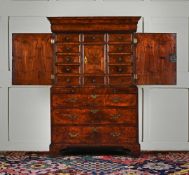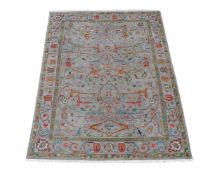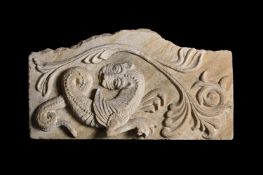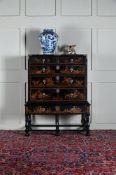A PAIR OF REGENCY EIGHTEEN-INCH LIBRARY GLOBES
BY J. AND W. CARY, LONDON, PUBLISHED 1816
Each sphere applied with two sets of twelve hand-coloured engraved split half-gores, the terrestrial incorporating circular printed panel inscribed C ARY'S, NEW TERRESTRIAL GLOBE, EXHIBITING, The Tracks and Discoveries made by, CAPTAIN COOK:, Also those of CAPTAIN VANCOUVER on the, NORTH WEST COAST OF AMERICA, And M. DE LA PEROUSE, on the COAST of TARTARY, TOGETHER, With every other Improvement collected from Various navigators and Travellers, to the present Time., LONDON: London. Made & Sold by J. & W. Cary, Strand, March 1st 1816. , extensively annotated with fully graduated equatorial calibrated in minutes and degrees, ecliptic and meridians, the Pacific ocean with an analemma TABLE of EQUATION , many explorers' tracks and numerous notes and dates, Antarctica with no land shown, the continents with nation states faintly colour-outlined, showing cities, towns, rivers, mountains in pictorial relief; the celestial with printed oval panel inscribed CARY'S, NEW CELESTIAL GLOBE, on which are laid down, THE WHOLE of the, STARS AND NEBULAE &c., Contained in the Astronomical Works of the, REV'D F. WOLLASTON F.R.S., De la Caille, Herschel, Hevelius, Mayer, Flamsteed, Bradley &c., Made & Sold by J. & W. Cary, Strand, March 1st 1816. , the axis through the celestial poles, with fully graduated equatorial and ecliptic with twilight zone, the constellations depicted by mythical beasts and figures with dotted boundaries, the stars shown to nine orders of magnitude with clusters and nebulæ and labelled; both spheres with engraved brass hour dials to the poles and pivoted within brass meridian circles divided for degrees, the hand-coloured engraved paper horizon rings with compass points and degrees in both directions, pictorial representations of the Zodiac, calendar scales and wind directions; each supported on an oak and elm tripod stand incorporating four quadrants supporting meridian ring over baluster upright and downcurved supports terminating with tapered feet fitted with brass castors
112cm high, 63cm wide
Provenance:
The Guy Reed Will Trust, Copgrove Hall, Yorkshire
The celebrated Cary family business of scientific instrument and globe makers was established by John Cary at Johnson's Court, Fleet Street, London in 1782 moving to a new address at 'Corner of Arundel Square', Strand the following year. He was primarily an engraver of maps, charts and globes who moved again in 1783 to 188 Strand. By 1791 he had entered into what appeared to be a relatively casual partnership with his brother, William; this partnership lasted until circa 1816 by which time William and John Cary had moved again to 181 Strand before finally settling in 86 St. James in 1820. The following year he was succeeded by his sons, John (II) and George Cary, who continued from the firm's 181 Strand address until 1851/2 when the business was acquired by Henry Gould.



























































